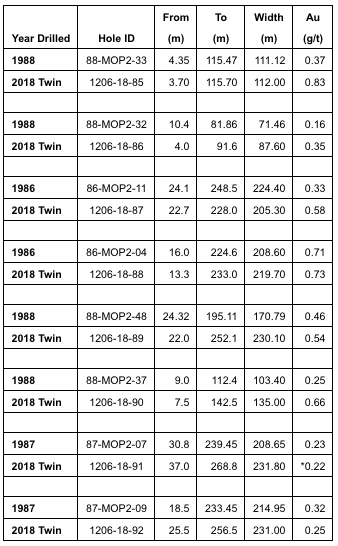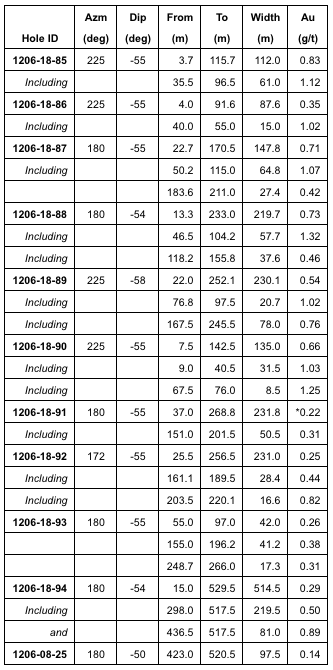By Pia Rivera
Enforcer Gold Corp (“Enforcer” or the “Company”) (TSXV: VEIN, FSE: N071) is pleased to announce the results from its 2018 Phase 1 diamond drilling program on the MOP II gold-copper deposit. The Roger Project is located 5 km north of Chibougamau, Quebec, has all-season road access and is crossed by a power line that serviced the past-producing Troilus Mine. Enforcer is earning a 50% interest in the project from project operator, SOQUEM.
The 2018 Phase 1 program was completed in April with the drilling of 11 holes totalling 3,068 m. The primary objectives of the program were the twinning of 8 historic holes on the Main zone, for which the core is no longer available, and deeper drilling (>300m vertical) to determine if mineralization continues at depth on the eastern portion of the deposit.
Highlights include:
- Hole 1206-18-85: 0.83 g/t Au over 112 m
- Hole 1206-18-87: 0.71 g/t Au over 147.8 m
- including 1.07 g/t Au over 64.8 m
- Hole 1206-18-88: 0.73 g/t Au over 219.7 m
- including 1.32 g/t Au over 57.7 m
- Hole 1206-18-89: 0.54 g/t Au over 230.1 m
- Hole 1206-18-94: 0.29 g/t Au over 514.5 m
- including 0.89 g/t Au over 81.0 m
- including 0.50 g/t Au over 219.5 m
President and CEO, Steve Roebuck, comments:
“Results from the twinned holes have exceeded our expectations in that the mineralization is very consistent throughout each hole and in most cases the grades and widths exceed the historical results. This has significantly boosted our confidence on the potential for defining a bulk-tonnage deposit at Mop-II that is potentially amenable to lower-cost, open-pit mining techniques. With the historic data now validated, the Company has a robust database to work with and will proceed with updating the resource estimate, targeted for release later this summer. Planning for the next phase of exploration is underway with emphasis on targeting areas that have the best potential to increase the resource base.”
The 8 twinned holes have verified the results from the 8 historical holes (Table 2) with mineralization beginning at or near surface and continuing for significant lengths down hole. Holes 1206-18-93 and 94 were collared to the east of the lesser explored North zone and drilled to intersect the Main zone at depth. Both holes intersected mineralization on strike of the North zone, extending its potential strike extent to over 450 m. Hole 1206-18-94 demonstrated continuous lower-grade mineralization over an impressive 514.5 m of core length to a vertical depth of ~400 m. Hole 1206-08-25 was a deepening of historical hole 1206-08-25 from 375 to 521.5 m down hole, also confirming that a very broad halo of lower-grade mineralization extends at depth below the Main zone.
Detailed drill hole location plans and cross sections are available in the Roger Map Gallery.
Table 1. Significant Results from the 2018 Phase 1 Drill Program
Notes to Table 1:
All holes presented in Table 1 were completed by NQ diamond (core) drilling. Widths represent down hole core lengths; true widths are unknown at this time. *Hole 1206-18-91 intersected underground workings from 128.3 to 131.2m downhole; hence, 2.9 m of drill core is missing from the intersection where host rock with potential mineralization has been mined out. As such, the true grade of the intersection is unknown and a value of “0” was assigned to the interval.
The 8 holes presented in Table 1 were drilled to twin 8 holes drilled by Flanagan Inc. from 1986 to 1988. These historical holes were selected in order to achieve a representative sampling of the mineralized zone rather than targeting the best historical grades. The twinning program has successfully corroborated the results of the historic drilling and in all cases returned anomalous gold beginning at or near surface and extending over very significant widths.
Table 2. Comparison of Historic (1986-1988) and 2018 Twin Hole Results

Notes to Table 2:
All holes presented in Table 2 were completed by diamond (core) drilling. Widths represent down hole core lengths; true widths are unknown at this time. *Hole 1206-18-91 intersected underground workings from 128.3 to 131.2m downhole; hence, 2.9 m of drill core is missing from the intersection where host rock with potential mineralization has been mined out. As such, the true grade of the intersection is unknown and a value of “0” was assigned to the interval. All non-assayed intervals in the historical holes were assigned a value of “0”.
Gold mineralization at the MOP-II deposit correlates with broad alteration zones of sericitization and silicification that are largely contained within a 2.2 km long by 0.4 km wide quartz-feldspar porphyry intrusion. The mineralization is homogenous, generally low grade and occurs over broad intervals. In addition to the 58,000 m of diamond drilling now completed on the Roger property, underground exploration undertaken in 1988 included 1,177 m of development and over 1,000 m of chip sampling.
Historical Resource Estimate
As reported on January 22, 2018, a 2006 NI 43-101 compliant mineral resource estimate on the deposit by Scott Wilson Roscoe Postle Associates Inc. for SOQUEM, estimated using an average long-term gold price of US$500 per ounce, totalled 167,200 ounces of gold in the Inferred Resource category as follows:
Historical Inferred Resource Estimate – January 2006
N.B.: Enforcer considers the 2006 estimate as a historical resource estimate that has relevance to the project; however, a qualified person for the Company has not done sufficient work to classify the historical estimate as a current mineral resource and as such it should not be relied on.
QAQC
The 2018 Phase 1 drilling program was managed by project operator, SOQUEM, utilizing standard industry procedures and protocols and following a formal quality assurance and quality control (“QAQC”) program. Sample preparation and analysis were performed by ALS Minerals in Val-d’Or, Quebec, a CAN-P-1579, CAN-P-4E (ISO/IEC 17025:2005) accredited testing laboratory. Gold grades are determined using a standard fire assay with atomic absorption finish on a 30g pulverized fraction. Samples grading above 2 g/t are re-assayed using fire assay with gravimetric finish on a 30g fraction on both the pulps and rejects. SOQUEM routinely inserts …read more
From:: Investing News Network

